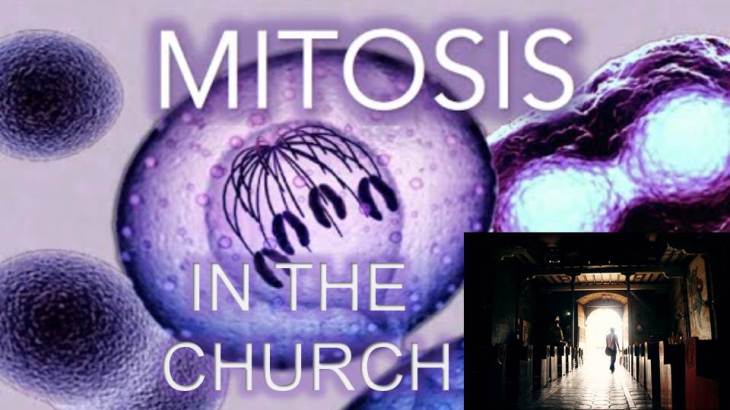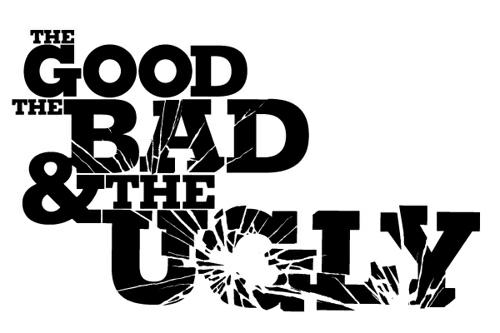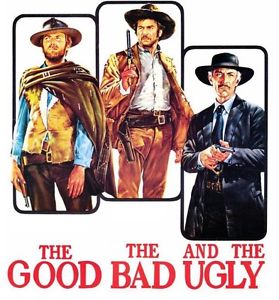
In my last post (The Good, The Bad And The Ugly) I put out there my hope that the upcoming General Conference would result in a mitosis because unity is an impossibility. I do NOT hope for this mitosis out of any anger or bitterness toward any person or group. And this hope does NOT come out of despair or weak resignation in my heart. Should this mitosis happen, as it should, I would pray that both cells, or all 3 cells (I know a 3-cell mitosis violates the laws of biology, but we’re talking about the movement of God through the Holy Spirit–and they are not controlled by the laws of biology), would move forward by bringing the Good News of the Kingdom of God to all people living in darkness and who are broken. I pray that each “cell” would bring sight to the blind, a dance to the lame, a song to the mute, and the release of all prisoners so that all might experience life as God intends.
Here is the vision that I have for all of those “cells”. Without a clean break from the “old” cell, we simply replicate what has been now described and dysfunctional and powerless. If you have other ideas or vision for these new “cells”, feel free to share them in the comment section below. So, at this time, would everyone please buckle your seat belts as we prepare for take-off. Here they are, in no particular order of importance:
1. Organized Networks
Currently we call them Annual Conferences. In the new “cells” I would call them Networks because of the negative connotations that have come out of our current system. I believe the Body of Christ is connected to and not independent of each other. My spirit groans when I see the word “independent” in a church name. Paul said we are the body of Christ, deeply connected to each other. There are times when there is frustration, much frustration in numbers, there is also great strength in numbers. These “Networks” would be based on geography so that we could work closer together. Each Network would determine how many Regions or Clusters (now called Districts) are necessary to fulfill the Mission (see Point 3). These Networks would also be given the task of reviewing those seeking to become pastors of local churches. Both laity and clergy would vote on those seeking to become pastors.
2. Shared Core Values
We don’t have this now, but in a new cell, we could. Determine ahead of time what is the essentials, so that there can be liberty in the non-essentials and in all things live a life of love. This is not limited to the arena of human sexuality. That being said, each “cell” should have an undeniable understanding of what is and is not acceptable to God. The “cell” I would align with will be the one that views the sexuality God established before The Fall. One man and one woman faithfully together in life, uniquely revealing the image of God. It would also allow as a core value system, what Peter preached in Jerusalem on that Feast of Pentecost–that young and old, men and women are equal in Christ. Well, I could go on, but I will stop here.
3. A Clearly Defined Mission
That mission must be about people rather than institutions. The Mission must be about helping people experience life the way God intends life to be experienced. This is what Jesus meant when He said, “I have come that you might have life to the fullest.” This means we get to know the people around us; where they are hurting, what they are missing, where they are struggling. The Mission will not be about committees or buildings or programs. It will all be about people who are not yet in the Kingdom of God.
4. Elimination Of The “Trust Clause”
For my non United Methodist Readers, allow me to explain as best I can, this “Trust Clause”. The real property and all other assets of each United Methodist congregation is not their own, but held in “trust” by the Annual Conference under which they exist. Currently, if they want to leave, they have to give up their real property and all other assets to their Annual Conference, OR, negotiate a fair and equitable settlement with that Annual Conference (i.e. pay an agreed upon amount of money).
This Trust Clause has been used to keep member in line with the leadership of an annual conference; or pay the price. These Networks of new cells would have no such clause. Each local congregation would maintain ownership of all their assets. If they do things contrary to their “Network”, then the Network simply removes them from the list of congregations of their Network and the local congregation is then free to pursue God as they believe He is leading them.
5. Elimination Of The Episcopacy
This is perhaps the most radical part of my plan. Again for my non United Methodist readers, the Episcopacy is another way of saying “Bishops”. Currently bishops are elected at the Jurisdictional Conference level and appointed by the Jurisdictional Conference and they are bishops until they die. The episcopacy has in the past, served us well. But take the time to read about Bishop Francis Asbury and how he led. Or read about Bishop Thomas Coke’s leadership style. This office was important then, but not so much now. The title of “bishop” is a leftover remnant of the mitosis of the Church of England and Roman Catholic Church. In a time when educating the masses was difficult, even unheard of, such an office was necessary. But today people have more opportunities and the means to inform and equip themselves to our Holy Task.
In lieu of the office of bishop, I would propose a “Presiding Elder” (from our old terminology) or a “Presbyter” (from the New Testament). This CEO type leader would be selected from pastors serving in local congregations within the local “Network” to serve for a period of 6 years. After that 6 year period, they would make the commitment to go back to serving congregations at least 6 more years; barring illness, disability or death. Leadership would remain within the local network, rather than a select committee outside the geographic network. Thus, the office of “Bishop/Presbyter” would not be a lifetime title, but a time of servant leadership. And if that isn’t controversial enough, this next one will be even more controversial.
6. End The Use Of ‘Deacon’ and ‘Elder’ as a title for clergy and specialized ministry.
On this point I fully expect a severe backlash from my fellow UMC pastors. As I read the New Testament, I see that the primary leadership offices of deacon and elder were from among what we would call the laity. The clergy class, and it is a ‘class’, came much later. I assert that this ‘class of clergy’ has outlived its usefulness. By the emphasis on ordination as deacon and elder, we have declared the laity, in essence, impotent without us clergy types.
This new Wesleyan Methodist movement goes back to our roots. Further back than John Wesley, but back to another John (and Matthew and Peter and Andrew and….you get the point). Most agree that we have created a top-heavy institution. The New Wesleyan Methodist Movement will be a grass-roots up movement. Geographical Networks (now called Annual Conferences) would be structured to serve the local congregations, not the other way around, as it is now. Clergy would be clergy–preaching, teaching, and ordering the life of the local congregation around The Mission.
Now, my next point may offend the lay folks, Who am I kidding? It will infuriate some.
7. Continue the itinerant system, but each appointment would be for 4 years at a time, rather than 1 year at a time
For you non United Methodist readers, let me explain the itinerant system. It is a system where pastors are sent and received, directed by a group known as the Cabinet. Some of my lay friends would hope that I would advocate eliminating itineracy and thus give them more power to choose their pastor. I remind you what Winston Churchill once said: “Democracy is the worst form of government, except for all others.” I believe that itineracy is the worst way to match churches with pastors, except for all other ways.
Back to the Network. Each Network decides how many Regions/Clusters are needed. Each Region/Cluster would have a Leader, who along with the Presbyter and local churches, work together to make appointments with pastors and congregations for 4 years at a time. This encourages partnership between pastor and congregation. It would discourage pastors from seeking their next appointment before God is through with them at their current appointment. It would discourage congregations, for at least 3 years, not to think about how to get rid of their current pastor. I believe this would change the focus from what’s next to what’s now.
8. Entirely New Structures
Our current structure is Annual Conference every year. Jurisdictional and General Conferences every 4 years. I am now being reminded of the truthful adage: The definition of insanity is to do the same things over and over while expecting different results. The New Wesleyan Methodism would have different structures.
1. First eliminate Jurisdictional Conferences. The “big thing” at Jurisdictional Conference is the election of bishops. Since the New Wesleyan Methodism empowers each geographical area select its leadership, this gathering would be moot.
2. Change from “annual” conference to Biennial Gathering. Business would be planned and approved once every 2 years. Every church sends 1 delegate and all pastors regardless of their current classification would be allowed to vote on all matters; no exceptions. This is radical I know. One reason I would hear against this is the balance of having equal number of clergy and lay delegates. If this balance is necessary, it’s a sign of distrust. Another objection would be that only “qualified” clergy should vote on clergy matters. Talk about class elitism; this practice needs to end. Then in those “odd” years we don’t meet for business, we gather for worship, praise and a variety of studies designed to help local congregations engage in their Mission. I would liken these odd year gatherings to that of the New Room Conferences. If you’ve never been to one, you should!
3. Change ‘General Conference’ to Global Gathering. Here our polity, rules, and doctrine are established. Each Network (now called Annual Conferences) would send 12 delegates, 6 lay people and 6 pastors, to represent their area Network. The meetings would be presided over by the collective Presbyters of each Network. At the end of this Global Gathering, each delegate and Presbyter would affirm their commitment to support and uphold the established polity and doctrine. After the report is shared with each congregation, they would make covenant also to support and uphold the decisions made.
Well, I know this is a big dream. I know it is also controversial for some. But then, big dreams are like that. Jesus came to the Jewish Community with a big dream, a God-sized dream. It was indeed controversial to some. It was even considered to be foolish. But to those of us who believed the Message of this Kingdom, it is the power of salvation.
Feel free to add to or take away from anything I’ve written. I freely admit that I do not have all the answers–but I do know, and walk with the ONE who has those answers.


You must be logged in to post a comment.